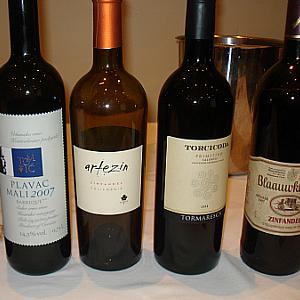Zinfandel has long been claimed as America’s grape – certainly there is more planted there than anywhere else – but for quite a long time that claim has been disputed by those who believed it was related to an Italian grape variety. Recent studies of the DNA of the grape has now proved conclusively that Zinfandel originates from a grape variety called Crljenak Kaštelanski which was first identified in Croatia. Most of these vines were destroyed in a Phylloxera epidemic in the 19th century but nine years ago, the last remaining few vines were discovered on the Dalmatian coast and used to produce the first single varietal Crljenak Kaštelanski wine for two centuries.
From Croatia, it appears that the grape did migrate to Italy, becoming known as Primitivo and settling in the Puglia region where it makes dark, concentrated wines. From thence it made its way to America via the Viennese Imperial Collection of Plant Species, travelled West during the 1840’s Gold Rush and immediately thrived in the Californian sun. Zinfandel has become America’s signature grape with more than 50,000 acres planted to the variety and over 300 cellars making a version of their own.
According to Blaauwklippen cellarmaster, Roelf Zeitvogel, Zinfandel is a tricky grape to grow. It ripens very unevenly which means that either some of the grapes are green when harvested or, as happens most often, they are left to hang until all are ripe by which time, many of them have become raisined and sweet. Blaauklippen are one of only 3 producers still making Zinfandel in South Africa and Roelf admits it is sometimes a labour of love. They reduce the bunch sizes by half in an effort to get them to ripen at the same time and go onto lose even more fruit on the sorting table. But the late ripening still results in higher than normal alcohol levels and a distinctive raisined quality to the wines much of the time.
But still they persevere, building on the heritage laid down by Walter Finlayson more than thirty years ago. As part of their commitment to the variety, Blaauwklippen has become the first Southern Hemisphere producer to join the Zinfandel Advocates & Producers organisation, based in the USA, and they also host an annual Zinfandel tasting showcasing examples of the grape from around the world. Blaauwklippen make a few versions of Zinfandel and also uses it as a blending component as well. Their White Zinfandel is inspired by the blush versions of California and is a complex wine with hints of marzipan and cream whilst their Noble Late Harvest is an idiosyncratic wine which pairs well with berries and chocolate.
At this year’s event held last week, wines from California and Italy were put up against the closest Croatian example to be found – a Plavac Mali which is a cross between Crljenak Kaštelanski and another local variety called Dobricic. Alongside these wines was a 1997 Blaauwklippen with a surprisingly modest 13.15% abv. Somewhat stinky on the nose, it was nonetheless elegant and juicy with a pleasing black fruit jam quality and a good length. Perhaps if Zinfandel can produce wines like this, it may well be worth persevering with it in SA!

